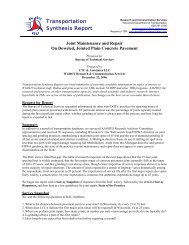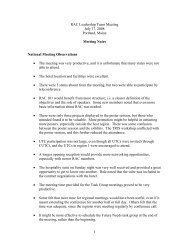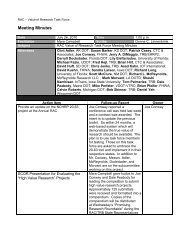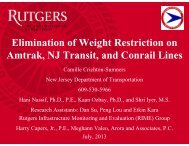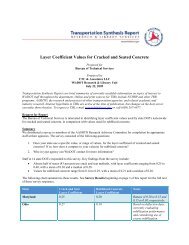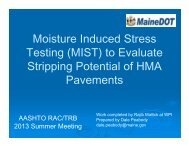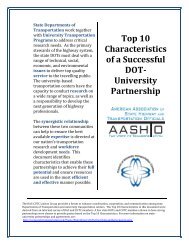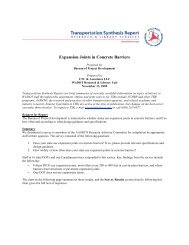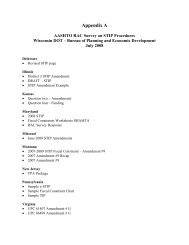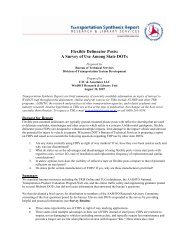PART IV: Summary of Comments - SCOR/RAC
PART IV: Summary of Comments - SCOR/RAC
PART IV: Summary of Comments - SCOR/RAC
Create successful ePaper yourself
Turn your PDF publications into a flip-book with our unique Google optimized e-Paper software.
<strong>PART</strong> <strong>IV</strong>: <strong>Summary</strong> <strong>of</strong> <strong>Comments</strong>17-May-10Reviewer <strong>Comments</strong> Distribution <strong>of</strong> Ratings■ Complementary to L07 (design features for wildlife management)Item #116:B-16Further Refinement and Implementation <strong>of</strong> a HabitatQuality Index(17)(46)NR 0 1 2 3 4 5<strong>SCOR</strong> 3 3 5 3 3<strong>RAC</strong> 2 6 10 13 9 7 2Standing Committee on Research■ Sounds like UDOT has developed a promising tool that other state DOTs might want to try to adapt. This is an importanttool that that has high implementation prospects across the country. I'd like to see more details on how the HQI isdifferent than others that have been developed, but this is a strong research need that deserves attention.■ Habitat evaluation methods are plentiful■ See NCHRP reviewer's comments.■ There are a number <strong>of</strong> Habitat indices existing already. Science isn't the issue, policy formation is.■ Add to NCHRP 20-25■ This project has good intentions, but I find it difficult to see how it will produce something that is useable throughout theUS in all habitats. Maybe concentrating on endangered species should be a preliminary goal. Some states may havealready done this type <strong>of</strong> habitat analysis as part <strong>of</strong> their Wildlife Action Plan.■ [Rating: 3] The need is high for this type <strong>of</strong> work. This would rate a 4 or 5 if the focus were on piloting the existing HQIto demonstrate regulatory buy-in, rather than expanding the HQI to other habitat types and a larger geographic scale withno guarantees that regulatory agencies will adopt it.Research Advisory Committee■ Low need and low benefit for all the states.■ This appears to be a regional tool and not likely to be broadly applied outside Utah. There have been many, efforts likethis to develop a quick, simple, scheme for judging ecological systems all over the country for a myriad <strong>of</strong> different uses.Most <strong>of</strong> them don’t stand the test <strong>of</strong> time because ecological systems are rather complex. The ones that do get used fit avery specific niche application and generally are developed (and thus valued) by regulators. This is not a good use <strong>of</strong>national research dollars in my view.■ The description <strong>of</strong> the research indicates that the approach is reasonable. All states can benefit from this research.Other■ [Rating: 2] The Committee believes that this study is not applicable to transportation. Additionally, it appears to be toospecies specific. We believe that the research will be quiet controversial and prone for error when done on a nationalscale.Item #117:G-15Traffic Signal "Yellow Trap"(17)(46)NR 0 1 2 3 4 5<strong>SCOR</strong> 4 4 4 1 3 1<strong>RAC</strong> 8 11 9 12 6 3Standing Committee on Research■ Not a priority.■ This problem statement is addressing a potential safety issue at signalized intersections.■ It has been recommended that existing yellow trap conditions be eliminated.<strong>IV</strong>-85



